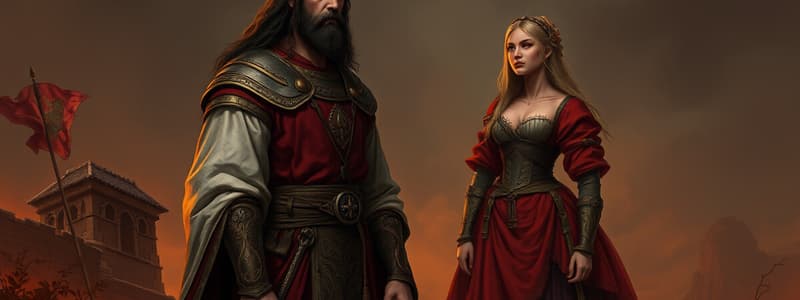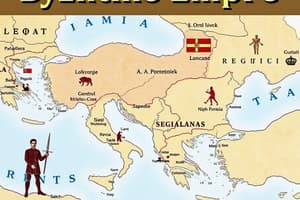Podcast
Questions and Answers
What is a paludamentum?
What is a paludamentum?
Cloak worn by upper class men and women of the 6th century Byzantine Empire.
What is a tablion?
What is a tablion?
A large embroidered square at the front of a paludamentum that proclaimed a high social status.
How did the Byzantine Empire influence European style?
How did the Byzantine Empire influence European style?
European royalty adapted Byzantine type of ornamentation for their clothing; they bought Byzantine silks.
What was the type of dress during the Dark Ages in Europe?
What was the type of dress during the Dark Ages in Europe?
What are braies?
What are braies?
What is a chemise?
What is a chemise?
What is an undertunic?
What is an undertunic?
What is an overtunic?
What is an overtunic?
What was the women's clothing like during the Early Middle Ages?
What was the women's clothing like during the Early Middle Ages?
What is a bliaut?
What is a bliaut?
What characterized Early 13th century styles?
What characterized Early 13th century styles?
What is a mantle?
What is a mantle?
What is a garnache?
What is a garnache?
What is a herigaut?
What is a herigaut?
What is a fillet?
What is a fillet?
What is a coif?
What is a coif?
What characterized the pace in change of styles during the Middle Ages?
What characterized the pace in change of styles during the Middle Ages?
What was men's style in the 14th century?
What was men's style in the 14th century?
What are the types of hose?
What are the types of hose?
What garments for men appeared in the Late Middle Ages?
What garments for men appeared in the Late Middle Ages?
What is a cote-hardie?
What is a cote-hardie?
What is a houppelande?
What is a houppelande?
What is a liripipe?
What is a liripipe?
What was the undergarment for women during the Late Middle Ages?
What was the undergarment for women during the Late Middle Ages?
What are the 4 elements of royal dress in France for women?
What are the 4 elements of royal dress in France for women?
What is a lappet?
What is a lappet?
What characterized outdoor garments for women?
What characterized outdoor garments for women?
What things got shorter in length in the 15th century?
What things got shorter in length in the 15th century?
What is a codpiece?
What is a codpiece?
What are doublets?
What are doublets?
What outdoor garments for men were common in the Late Middle Ages?
What outdoor garments for men were common in the Late Middle Ages?
What are pointed poulaines/crakowes?
What are pointed poulaines/crakowes?
What is a roc?
What is a roc?
What outdoor garments for women existed in the Late Middle Ages?
What outdoor garments for women existed in the Late Middle Ages?
Flashcards are hidden until you start studying
Study Notes
Byzantine Influence and Early Fashion
- Paludamentum: Cloak worn by the upper class in the 6th century Byzantine Empire, signifying authority.
- Tablion: A large embroidered square on the paludamentum, indicating high social status.
- Byzantine styles influenced European royalty, who adopted ornate clothing and imported lavish Byzantine silks.
Dark Ages Attire
- Clothing was a mix of Roman tunics and Barbarian leg wrappings.
- Braies: Linen undergarments for men, the modern "breeches" derives from this term.
- Chemise: Linen undershirt worn by men, often removed in labor settings, replaced by braies.
Tunics and Outer Garments
- Undertunic: Worn above the braies and chemise, typically shorter for laborers and longer for the upper class.
- Overtunic: Featured long sleeves and allowed for under tunic visibility.
- Women's clothing mirrored men's, but without braies and longer chemises.
12th to 13th Century Developments
- Bliaut: Complex 12th-century garment for upper-class individuals with intricate cuts and fits.
- Early 13th-century styles featured loosely fitted garments.
- Mantle: A common cape or cloak serving as outerwear, resembling a poncho.
- Garnache: Elaborate outerwear with a distinctive bib-like collar emerging in the 13th century.
- Herigaut: An outer garment with "fake" sleeves appearing around the same period.
Headwear and Accessories
- Fillet: A headband worn by young unmarried women.
- Coif: The most common head covering for men among the lower class.
- Rapid changes in fashion styles characterized the medieval period.
14th Century Styles
- Loose-fitting clothing became popular among men.
- Hose: Leg coverings that morphed into styles including footed hose and those with straps.
- New garments emerged for men, including houppelande, cote-hardie, and doublets.
Women's Fashion in the Late Middle Ages
- Cote-Hardie: A close-fitting garment with sleeves that varied in length and fullness between genders.
- Houppelande: Recognizable for its gathers or bunching at the front, served as an overcoat.
- Women wore linen chemises as undergarments, often featuring a cape-like outer garment.
Essential Accessories and Trends
- Liripipe: A lengthy hood seen in the Late Middle Ages.
- Codpiece: A pouch at the front of joined hose, prevalent for men during this era.
- Doublets: Short houppelandes that replaced the cote-hardie for men.
- Pointed Poulaines/Crakowes: Upper-class shoes with exaggerated pointed toes.
- Outdoor garments for both genders typically took the form of capes or cloaks.
Shifts in Fashion Trends
- Shortened lengths in garments were evident in the 15th century, including jackets and braies.
- Roc: A loose gown, commonly associated with women's attire.
- Changes in outdoor garments styles for women included capes and mantles.
Studying That Suits You
Use AI to generate personalized quizzes and flashcards to suit your learning preferences.




